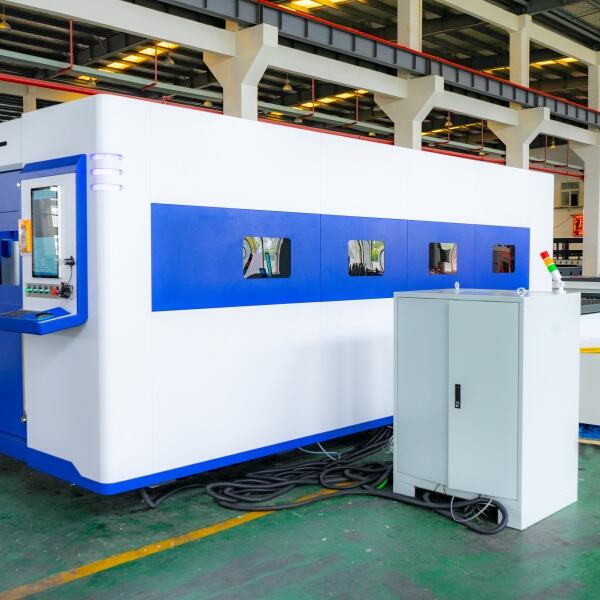Βασικές εργασίες συντήρησης για τις κεφαλές κοπής με οπτική ίνα
Καθημερινές διαδικασίες καθαρισμού και επιθεώρησης
Για να επεκταθεί η διάρκεια ζωής της μηχανής κοπής με οπτική ίνα και να επιτευχθεί καλύτερη ποιότητα κοπής, θα πρέπει να ακολουθούνται ορισμένες μέθοδοι, όπως η καθημερινή συντήρηση. Ξεκινήστε με οπτική επιθεώρηση της κεφαλής κοπής, ελέγχοντας αν κάτι είναι εμφανώς φθαρμένο ή υπό βλάβη – βεβαιωθείτε ότι ελέγχετε τους φακούς και τους καθρέφτες για οποιαδήποτε βρωμιά ή σωματίδια. Αυτά τα οπτικά στοιχεία θα πρέπει να καθαρίζονται προσεκτικά (με τα κατάλληλα υλικά καθαρισμού) και ποτέ με σκληρό πανί, για να αποφευχθούν γρατσουνιές. Επιπλέον, είναι σημαντικό να καταγράφονται τα ευρήματα κατά τη διάρκεια κάθε επιθεώρησης. Η τεκμηρίωση αυτή επιτρέπει την παρακολούθηση επαναλαμβανόμενων θεμάτων και καθιστά δυνατή την προσαρμογή των στρατηγικών συντήρησης όπως απαιτείται, με αποτέλεσμα τη σταθεροποίηση της συνεχούς απόδοσης της μηχανής.
Εβδομαδιαίος έλεγχος του συστήματος ψύξης
Το σύστημα ψύξης σε ένα μηχάνημα κοπής με φασματικό λέιζερ χρειάζεται εβδομαδιαία προσοχή για να διασφαλιστεί ότι το μηχάνημα συνεχίζει να λειτουργεί στην κορυφαία του απόδοση. Αρχικά, μπορείτε να ελέγξετε τη λειτουργία του ψύκτη, να βεβαιωθείτε ότι η θερμοκρασία του ψυκτικού υγρού είναι σταθερή και εντάξει. Αυτό περιλαμβάνει τον έλεγχο του ψυκτικού υγρού: να το συμπληρώσετε αν είναι χαμηλό, καθώς και να αναζητήσετε διαρροές που θα μπορούσαν να εμποδίσουν την κανονική λειτουργία του μηχανήματος. Είναι επίσης σημαντικό να αξιολογήσετε την καθαριότητα των πηνίων και των φίλτρων του ψύκτη και να τα καθαρίσετε όταν είναι απαραίτητο. Όταν διατηρείται η αποδοτικότητα του συστήματος ψύξης, ο κίνδυνος υπερθέρμανσης μειώνεται σημαντικά και αυξάνεται η εμπιστοσύνη στη λειτουργία του μηχανήματος.
Εβδομαδιαία συντήρηση ακροφυσίου και φακών
Η ακροφύσια και οι φακοί πρέπει να συντηρούνται μηνιαία για τη διατήρηση της φυσιολογικής ποιότητας κοπής και της ακριβούς κοπής στις μηχανές κοπής με οπτική ίνα. Αρχικά, ελέγχετε πλήρως τα ακροφύσια και τους φακούς ως προς τυχόν ενδείξεις που μπορούν να επηρεάσουν την απόδοσή τους, όπως φθορές ή η συνεχής θερμική καταπόνηση που προκαλεί απομαγνήτιση. Χρησιμοποιείτε μια εξειδικευμένη διαδικασία καθαρισμού με κατάλληλα καθαριστικά υγρά για φακούς και ακροφύσια. Αυτό εξασφαλίζει ότι αυτά τα εξαρτήματα λειτουργούν με τη μέγιστη δυνατή αποτελεσματικότητα. Επιπλέον, αν κάποιο εξάρτημα έχει φθαρεί, μπορείτε να το αντικαταστήσετε πριν προκληθούν προβλήματα στην παραγωγή και να διασφαλίσετε πάντα την ποιότητα του προϊόντος. Με τη φροντίδα και συντήρηση αυτών των εξαρτημάτων, η μηχανή σας θα συνεχίσει να παρέχει καθαρή και ακριβή κοπή κάθε φορά.
Βελτιστοποίηση της απόδοσης της κεφαλής κοπής σε ακραίες συνθήκες
Οι διατάξεις κοπής με φασματικό λέιζερ λειτουργούν υπό κρύες καιρικές συνθήκες. Με τις ακραίες καιρικές συνθήκες, ο χειριστής των διατάξεων κοπής με φασματικό λέιζερ πρέπει να δημιουργήσει ένα σύστημα για να εξασφαλίσει ότι οι εργασίες κοπής θα πραγματοποιηθούν με ασφάλεια και αποτελεσματικότητα. Η διακύμανση της θερμοκρασίας είναι ένας δείκτης του πόσο καλά μπορεί να διαχειριστεί η θερμοκρασία λειτουργίας, καθώς η διακύμανση της θερμοκρασίας θα επηρεάσει την απόδοση του λέιζερ και την ποιότητα κοπής. Για να το αποτρέψετε αυτό, απλώς χρησιμοποιήστε τον αισθητήρα θερμοκρασίας για τη διαχείριση της θερμοκρασίας κατά τη χρήση. Τα ευαίσθητα εξαρτήματα πρέπει να μονωθούν για να προστατευτούν από τις έντονες εξωτερικές θερμοκρασίες. Ακόμη και να φτάσει τόσο μακριά, ώστε να εφαρμοστούν, με βάση τις καιρικές συνθήκες, τα πρωτόκολλα λειτουργίας πρέπει να αλλάξουν. Αυτό θα μπορούσε να είναι, για παράδειγμα, διαφορετικές ταχύτητες κοπής για διαφορετικές θερμοκρασίες, ώστε να διατηρηθεί σταθερή η ικανότητα κοπής με λέιζερ.
Η υγρασία είναι εξίσου σημαντική όσον αφορά την πρόληψη ζημιών στον εξοπλισμό σας. Ακολουθούν μερικοί τρόποι με τους οποίους μπορείτε να αποφύγετε τον σχηματισμό συμπυκνώματος σε περιοχές με υγρασία: Έλεγχος της Υγρασίας στην Περιοχή Κοπής Η εγκατάσταση απορροφητικών υγρασίας ή κλιματιστικών μπορεί να επιτύχει αυτόν τον έλεγχο. Επίσης, είναι σημαντικό να τοποθετείτε οποιοδήποτε ηλεκτρονικό εξάρτημα σε υδατοστεγές περίβλημα για να αποφεύγονται ζημιές από υγρασία. Αυτό θα προστάτευε τα κρίσιμα σημεία από τη διείσδυση νερού, αλλά θα πρέπει να ελέγχετε τακτικά τους στεγανοποιητικούς δακτυλίους και τις μανσέτες. Αυτή η προληπτική στρατηγική αποτελεί τη βάση της διαχείρισης της υγρασίας και τον βασικό τρόπο προστασίας της διάρκειας ζωής του εξοπλισμού.
Η τακτική και η εφαρμοστικότητα των προγραμμάτων συντήρησης τίθενται υπό αμφισβήτηση το καλοκαίρι. Συμβουλές συντήρησης για το καλοκαίρι: Οι γενικές συμβουλές συντήρησης της περιόδου του καλοκαιριού είναι καλύτερα να εφαρμόζονται με ελέγχους συστήματος ψύξης κάθε 1-2 μήνες. Εναλλάκτες θερμότητας και συστήματα ψύξης που απαιτούν ΚΑΘΑΡΙΣΜΟ ΠΡΟΣ ΤΑ ΕΜΠΡΟΣ! Αυτό με τη σειρά του επιτρέπει βέλτιστη λειτουργία ακόμη και με υψηλότερα φορτία θερμικής πακετάρισης. Οι χειριστές πρέπει να εκπαιδεύονται στην αναγνώριση σημείων υπερθέρμανσης και στην εφαρμογή διαδικασιών έκτακτης ανάγκης, οι οποίες θα πρέπει να αποτελούν μέρος της συντήρησης της κεφαλής κοπής. Η τακτική συντήρηση το καλοκαίρι δεν έχει μόνο σκοπό τη διατήρηση της απόδοσης του εξοπλισμού, αλλά και την παράταση της διάρκειας ζωής του κατά τη διάρκεια δυσμενών καιρικών συνθηκών.
Αντιμετώπιση συχνών προβλημάτων κεφαλής κοπής
Αντιμετώπιση επιδείνωσης ποιότητας δέσμης
Η μείωση της ποιότητας της δέσμης μπορεί να επηρεάσει την απόδοση και την ποιότητα κοπής. Το πρώτο βήμα είναι να εντοπίσετε προειδοποιήσεις, όπως απώλεια εστίασης ή υπερβολική ποσότητα θρυμματιών στις κοπές. Αυτά τα προβλήματα μπορεί να οφείλονται σε γρατσουνιές ή βρόχθινα οπτικά εξαρτήματα, γι' αυτό η εξέταση των φακών και των καθρεφτών είναι απαραίτητη. Η αντικατάσταση οποιουδήποτε εξαρτήματος που έχει υποστεί ζημιές μπορεί να βοηθήσει στην επαναφορά της απόδοσης σε καλή κατάσταση. Επιπλέον, η βελτιστοποίηση των παραμέτρων της διαδικασίας λέιζερ, όπως η θέση εστίασης και η ισχύς, θα συμβάλει στην αύξηση της αποδοτικότητας κοπής. Η τακτική βελτιστοποίηση και οι συχνές ρυθμίσεις είναι ζωτικής σημασίας για την παρακολούθηση της δέσμης.
Επίλυση προβλημάτων ευθυγράμμισης ακροφυσίου
Η ακριβής κοπή απαιτεί σωστή ευθυγράμμιση της ακροφύσιας. Η εκτροπή της ευθυγράμμισης θα οδηγήσει σε κακή κοπή, γι' αυτό είναι πολύ σημαντικό να χρησιμοποιούνται εργαλεία ευθυγράμμισης με λέιζερ για την επαλήθευση της ευθυγράμμισης. Οι ρυθμίσεις πρέπει να γίνονται σύμφωνα με τις οδηγίες του κατασκευαστή, να καταγράφονται και να διατηρούνται για αναφορά. Είναι απαραίτητο να επανεπιβεβαιώνεται η ευθυγράμμιση κάθε φορά που έχουν αντικατασταθεί νέα εξαρτήματα ή έχουν γίνει σημαντικές ρυθμίσεις στη μηχανή, προκειμένου να διασφαλιστεί ότι διατηρείται η ακριβής κοπή. Οι περιοδικές επιθεωρήσεις και ρυθμίσεις μπορούν να αποτρέψουν την εκτροπή της ευθυγράμμισης της ακροφύσιας και να διατηρήσουν την υψηλή ποιότητα κοπής.
Διόρθωση μη ομοιόμορφου πλάτους κοπής
Οι μη ομοιόμορφες επιφάνειες κοπής θα οδηγήσουν σε κακή ποιότητα και ακρίβεια κοπής. Είναι κρίσιμο να επιλύσετε αυτό το πρόβλημα και να ελέγξετε τα αποτελέσματα κοπής σε αρκετά διαφορετικά υλικά! Σε αυτό το στάδιο θα πρέπει να εξεταστούν και να αντιμετωπιστούν πιθανοί ύποπτοι, όπως φθαρμένα ακροφύσια ή λανθασμένες ρυθμίσεις εστίασης. Αυτού του είδους δοκιμή σε τύπο υλικού μπορεί να βοηθήσει στη ρύθμιση των παραμέτρων για το πλάτος κοπής. Επιπλέον, εντοπίζοντας και διορθώνοντας την πηγή των ακανόνιστων, μπορούμε να βελτιστοποιήσουμε τις διαδικασίες μας για να επιτύχουμε συνεχείς και υψηλής ποιότητας κοπές. Η τακτική επαναδοκιμή και επαναστοχοποίηση είναι απαραίτητη για να διατηρηθεί η μέγιστη ακρίβεια κοπής.
Προηγμένες Τεχνικές Συντήρησης για Μακροχρόνια Αξιοπιστία
Στρατηγικές Λίπανσης για Κινούμενα Εξαρτήματα
Ο λιπαντικός παράγοντας είναι απαραίτητος για τη μείωση της φθοράς στα κινούμενα εξαρτήματα των μηχανημάτων. Είναι σημαντικό να υπάρχει ένας καθορισμένος κύκλος λίπανσης, βασισμένος στις προδιαγραφές του κατασκευαστή (OEM). Αυτό εξασφαλίζει ότι όλα τα εξαρτήματα κινούνται ομαλά και μειώνεται η τριβή και η φθορά. Προτείνεται να επιλέγονται προϊόντα λίπανσης που είναι κατάλληλα για υψηλές θερμοκρασίες και μικρή φθορά στα βασικά εξαρτήματα. Επίσης, είναι πλεονέκτημα να υπάρχει ένα σύστημα παρακολούθησης των εργασιών λίπανσης. Αυτό δεν βοηθά μόνο στη διαμόρφωση ενός προτύπου συντήρησης, αλλά μπορεί επίσης να βοηθήσει στην ανίχνευση προτύπων που ίσως υποδεικνύουν κρυμμένο πρόβλημα, επιτρέποντας την επίλυση προβλημάτων πριν εμφανιστούν.
Παρακολούθηση Ποιότητας Ψυκτικού
Η ποιότητα του ψυκτικού υγρού παρακολουθείται επίσης. Η συχνή επιθεώρηση με δοκιμές pH και αγωγιμότητας μπορεί να είναι χρήσιμη για την έγκαιρη ανίχνευση προβλημάτων στο ψυκτικό υγρό, τα οποία διαφορετικά θα μπορούσαν να οδηγήσουν σε διάβρωση ή άλλη φθορά εξαρτημάτων. Η καταγραφή των αλλαγών και των επεξεργασιών του ψυκτικού υγρού επιτρέπει την παρακολούθηση της απόδοσης στη διάρκεια του χρόνου και η εμφάνιση τάσεων γίνεται ορατή. Διατηρώντας αυτές τις εγγραφές, είναι πιο πιθανό να γνωρίζετε πότε και πόσο συχνά πρέπει να αλλάζετε το ψυκτικό υγρό, κάτι που μπορεί τελικά να οδηγήσει σε πιο αποτελεσματική κοπή και μεγαλύτερη διάρκεια ζωής των εξαρτημάτων της μηχανής.
Προληπτικά Προγράμματα Αντικατάστασης
Ένα καλό πρόγραμμα προληπτικής συντήρησης είναι ζωτικής σημασίας για την πρόβλεψη της στιγμής που ορισμένα εξαρτήματα θα εμφανίσουν βλάβη, με βάση τον χρόνο και τη χρήση τους. Η προβλεπτική αντικατάσταση μπορεί να επιτευχθεί με καθαρό τρόπο με τη βοήθεια της ανάλυσης δεδομένων. Μελετώντας τις τάσεις χρήσης και ανασκοπώντας τις ιστορίες επιθεώρησης και επισκευής, μπορείτε να προγραμματίσετε την αντικατάσταση εξαρτημάτων και να αποφύγετε απρόβλεπτες διακοπές λειτουργίας. «Όταν όλη η ομάδα σας κατανοεί ότι το όφελος της προληπτικής αντικατάστασης είναι να πραγματοποιούνται επενδύσεις που αποτρέπουν τη βλάβη αντί να αντιμετωπίζεται αυτή αργότερα, θα αποδεχτούν το χρονοδιάγραμμα και η συμπεριφορά τους θα ευθυγραμμιστεί με την επιδιωκόμενη αντίδραση: ένα προληπτικό μέρος του μυαλού που εξασφαλίζει αξιοπιστία και αποτελεσματικότητα μακροπρόθεσμα.
Επίδραση της σωστής συντήρησης στα λειτουργικά έξοδα
Παράταση της διάρκειας ζωής των εξαρτημάτων
Η καλή συντήρηση διπλασιάζει την πιθανή διάρκεια ζωής των εξαρτημάτων της μηχανής. Είναι αποφασιστικής σημασίας να παρέχετε καλή συντήρηση στα εξαρτήματα για να μεγιστοποιηθεί η διάρκεια ζωής τους. Οι μηχανές που συντηρούνται τακτικά θα συνεχίσουν να λειτουργούν αποτελεσματικά για μεγαλύτερο χρονικό διάστημα. Αυτό σημαίνει επίσης να πραγματοποιούνται έγκαιρες επισκευές και αντικαταστάσεις εξαρτημάτων για να αποφεύγονται καταστροφικές βλάβες, οι οποίες θα είχαν ως αποτέλεσμα ακριβής χρόνος απόστασης λειτουργίας της μηχανής. Με την παρακολούθηση και αξιολόγηση των αριθμών της διάρκειας ζωής, οι κατασκευαστές μπορούν να αιτιολογήσουν τους προϋπολογισμούς και τις τακτικές συντήρησης, αποδεικνύοντας ότι κάθε δολάριο που επενδύεται ξανά σε σύγχρονες μηχανές είναι ένα δολάριο που στοχεύει στην καρδιά της μηχανής για να εξασφαλιστεί μια μακρά και υγιής διάρκεια ζωής.
Μείωση Της Κατανάλωσης Ενέργειας
Η καλή κατάσταση του εξοπλισμού μπορεί να επηρεάσει σημαντικά την ποσότητα της ενέργειας που χρησιμοποιείται, καθώς μπορεί να επιτευχθεί μείωση έως και 25% στο κόστος ενέργειας. Κυρίως επειδή οι μηχανές που λειτουργούν βέλτιστα, λειτουργούν πιο αποδοτικά και γι' αυτό χρειάζονται λιγότερη ενέργεια για να εκτελεστεί η ίδια εργασία. Οι μηχανές επιτυγχάνουν την πιο αποδοτική ταχύτητα κοπής, η οποία είναι αρκετή για να διατηρηθούν χαμηλά τα θερμικά φορτία, όταν είναι καθαρές και όταν συντηρούνται. Οι περιοδικές ενεργειακές επιθεωρήσεις μπορούν να επιβεβαιώσουν πώς οι πρακτικές συντήρησης επηρεάζουν την κατανάλωση και τα σχετικά κόστη ενέργειας και θα βοηθήσουν στον εντοπισμό θεμάτων που χρήζουν πρόσθετης προσοχής και συντήρησης.
Ελαχιστοποίηση της Απρόβλεπτης Διακοπής Λειτουργίας
Ένα αποτελεσματικό πρόγραμμα συντήρησης είναι απαραίτητο για την πρόληψη αιφνίδιων διακοπών οι οποίες μπορεί να είναι δαπανηρές, σε ορισμένες περιπτώσεις χιλιάδες δολάρια την ώρα. Με τη χρήση μεθόδων προγνωστικής συντήρησης, οι εταιρείες μπορούν να προβλέπουν βλάβες πριν συμβούν, να προστατεύουν τις γραμμές παραγωγής τους και να διατηρούν τις διαδικασίες τους εντός ορίων. Εξίσου σημαντική πτυχή για τη μείωση των διακοπών είναι και η κατάλληλη εκπαίδευση του προσωπικού ώστε να αναγνωρίζει τα σημεία που προμηνύουν βλάβες στον εξοπλισμό. Αυτή είναι μια προληπτική προσέγγιση που δεν έχει μόνο ως στόχο τη διατήρηση της επιχείρησης σε λειτουργία, αλλά αποτελεί και πλεονέκτημα για την επίτευξη μεγαλύτερης παραγωγικότητας και αποτελεσματικότητας.



